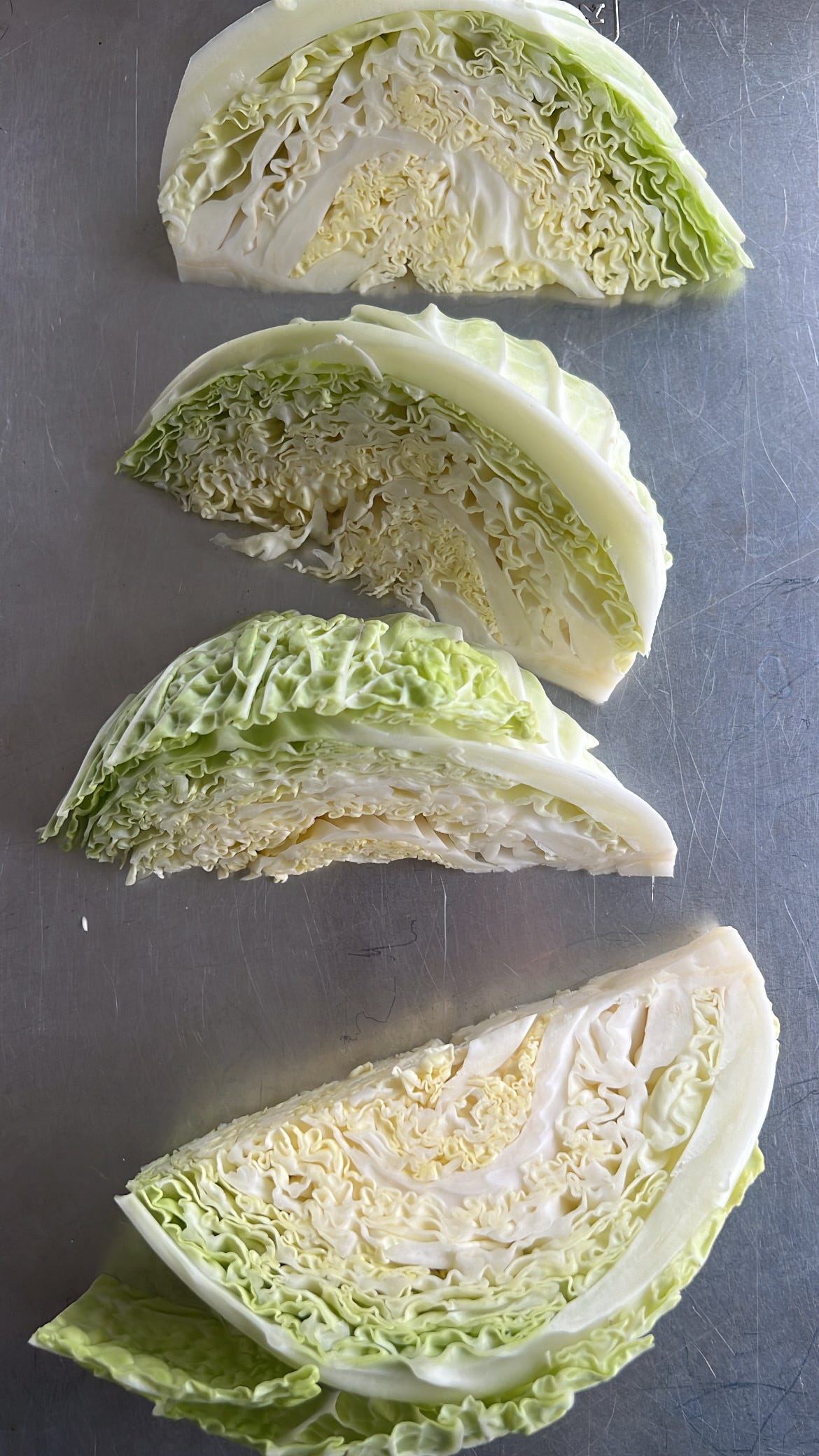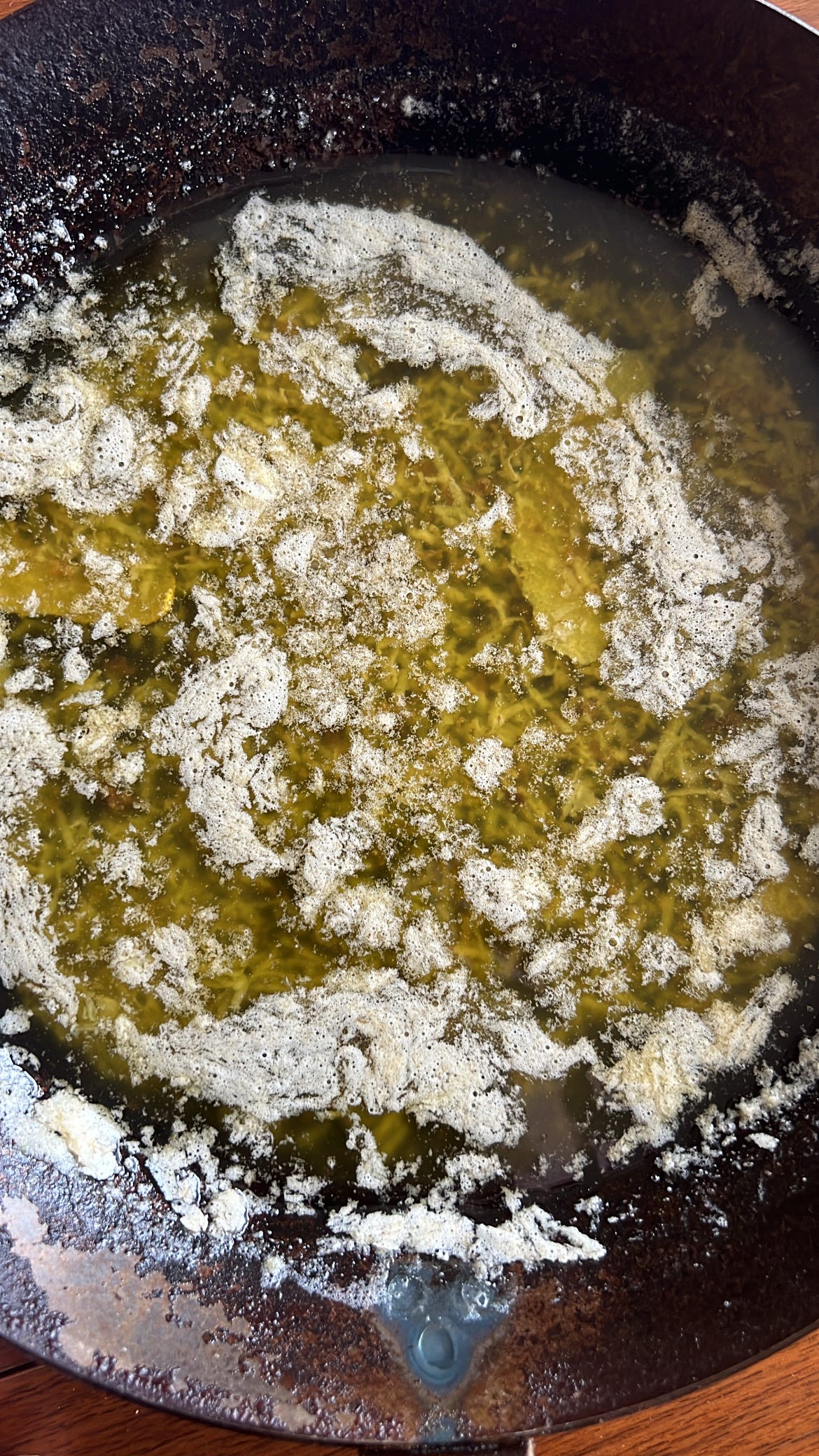These waning weeks of winter always feel like scraping the bottom of, well, a number of barrels. I’ve been wearing the same three outfits that manage to be warm, sort of interesting, and free of waistbands. The pantry and downstairs freezer1 are more or less cleaned out. The vibrancy of winter produce feels like it belongs in January with the freshness and the momentum and the resolutions.
February, on the other hand, feels like the real end of a year. We’re tired of winter, winter is tired of itself. Everything, including us, is washed-out. It seems right to make food that looks the way we’re feeling.
I’ve grown tired of photogenic food. I’m ready for ugly food.
Maybe for this reason, cabbage has always been one of my favorite vegetables to cook at home. Is it because, once cooked, it takes on a pale green, almost watery color that matches my tired February spirit instead of mocking me like the eye-welling brightness of, say, a bright squash or a carrot salad? Yeah, probably. It’s the sweatpants of vegetables.
Humble, versatile, and cheap, cabbage also goes the distance in the produce drawer, lasting for weeks (even months!). And they tend to be enormous, which, under the wrong circumstances, can make the vegetable feel like an imposition, a guest overstaying her welcome. You needed a little slaw for tacos two weeks ago and you’re still sitting on 3/4 of a cabbage the size of your head. And unlike some things in the produce drawer, it doesn’t have the decency to turn brown or go mushy quickly and get out of your life. It stares at you for weeks, staying crisp and hardy out of what feels like sheer spite.
So you can stay mad or you can make like 4 more meals out of it.
We’re gonna treat this cabbage series as if you’ve got a real bruiser bowling ball of a cabbage in the drawer and it’s time to use it up.
Today we’re starting with arguably the easiest preparation, requiring zero fancy knife work and only a passing interest in details like cooking times. You can make as much or as little cabbage as you like here, depending on whether it’s a Secret Lunch or a family dinner, but make the full batch of bagna cauda and store whatever’s left in the fridge.
Re. bagna cauda: don’t be intimidated by the fancy title. It means “hot bath” in Italian, and it’s literally meant to be a warm dip or drizzle for raw and cooked vegetables and meats. The version I make is similar to Abra Berens’ excellent version in her first book, Ruffage.
If you’re looking for a dream protein to go with this, spooning the bagna cauda over pieces of roasted chicken (done at home or store-bought) cannot be beat. Though now that I think of it, plopping a wedge of roasted cabbage on a bow of brothy beans, rivulets of bagna cauda running all throughout, sounds pretty good too.
Roasted Cabbage with Bagna Cauda
Serves 1 to 4, depending on how much cabbage you use
For the Cabbage
1/4 to 1 medium green cabbage (I also like frilly Savoy cabbage when I can find it)
Extra-virgin olive oil
Kosher salt2 and freshly ground black pepper
For the Bagna Cauda
1/2 cup extra-virgin olive oil
5 anchovies
3 garlic cloves, minced, grated, or pressed
2 or 3 strips of lemon peel
1 teaspoon kosher salt
1 stick unsalted butter
Make the cabbage: Preheat the oven to 400F.
Trim off any brown or dried-out parts of the cabbage’s root end and discard any brown or limp outer leaves. If you’re using 1/4 of a cabbage, cut it into 2 or 3 wedges, leaving the root end intact to hold the wedges together. If you’re using more than that, cut the wedges into a similar size.
Arrange the cabbage wedges on a baking sheet and drizzle all over with olive oil. I like to use my hands here to make sure the oil gets into the crevices, but it’s optional. Season generously with salt and pepper on both sides and roast for about 30 minutes, carefully flipping the wedges with tongs halfway through, until the edges are deeply browned and a little crispy on both sides. (If any leaves decide to slump off when you flip the cabbage, just gather them back in and continue on.)
While the cabbage roasts, make the bagna cauda: In a medium saucepan or skillet over low heat, add the olive oil, anchovies, garlic, lemon peel, and salt. Using a fork, gently mash the anchovies in the pan. (They’ll fall apart more on their own with the heat but I like to give them a start.) Cook, shaking the pan gently a few times, until the garlic and lemon are fragrant and the anchovies have pretty well disintegrated, 3 to 5 minutes. Add the butter and swirl the pan a bit to help it melt. When the butter is melted, remove the pan from the heat.
Arrange the roasted cabbage wedges on a plate and spoon the warm bagna cauda all over. Serve immediately.
Tell me you’re from the Midwest without telling me you’re from the Midwest.
Use whatever salt you have, I am a Diamond Crystal Kosher girlie. DC tends to be less salty, which makes it easier to modulate salt up or down. As always, taste your salt and salt to taste!







Great! Cabbage is so underrated. Hope you enjoy!
Love that I can hear you coaching me through this!